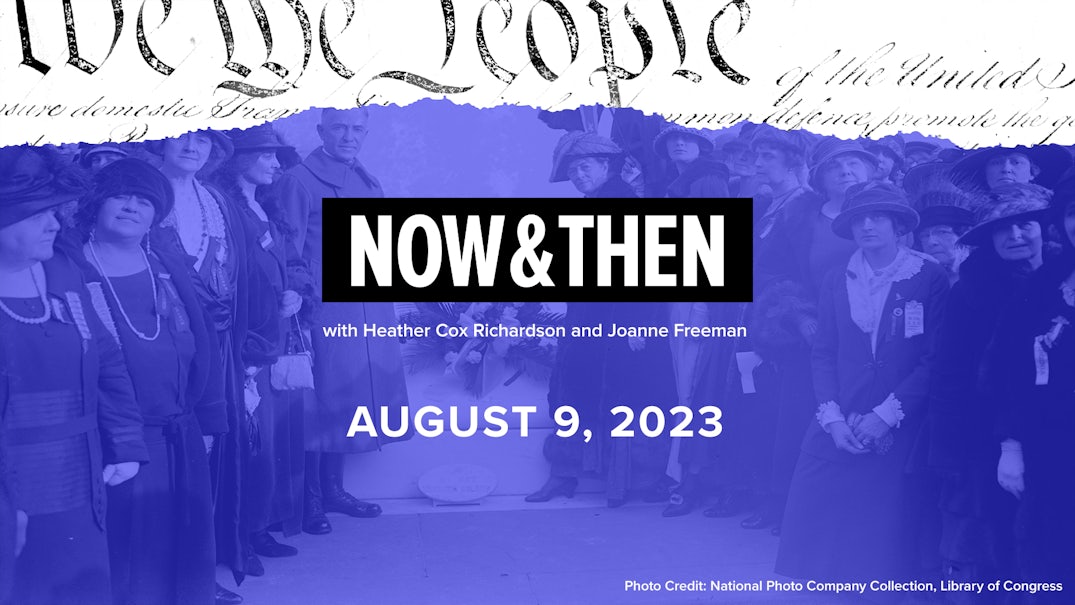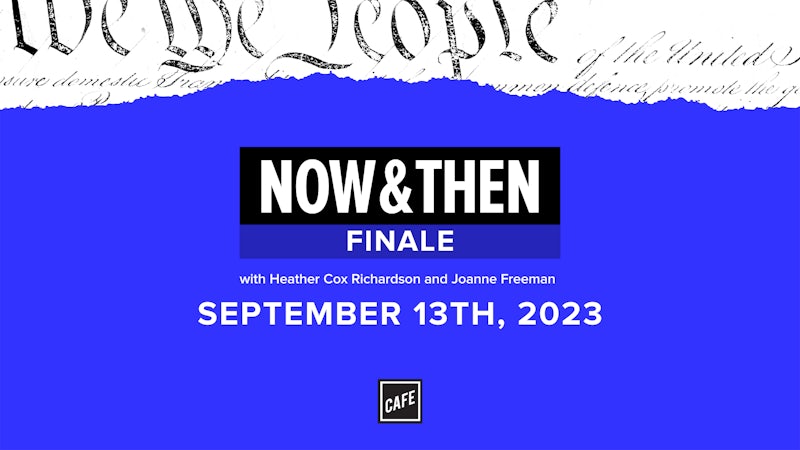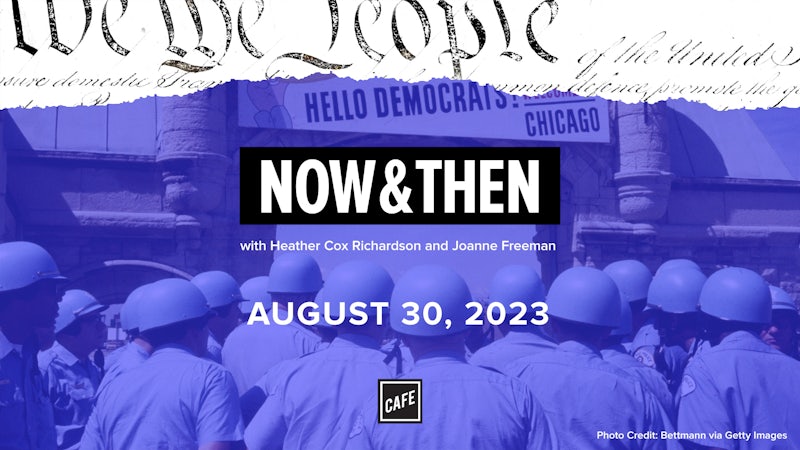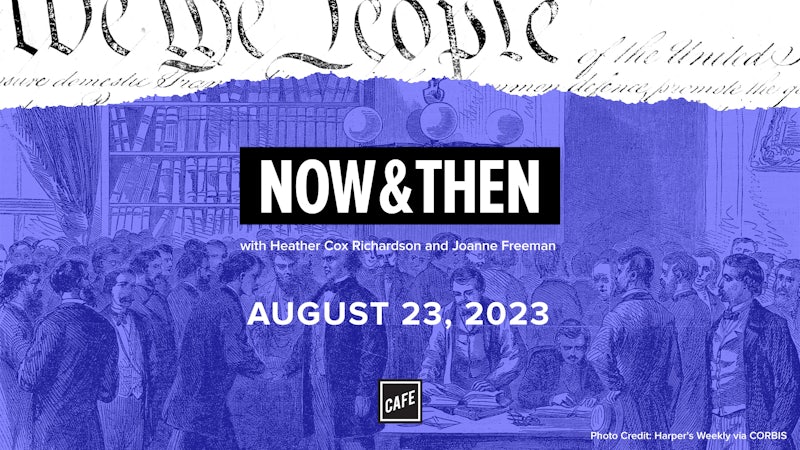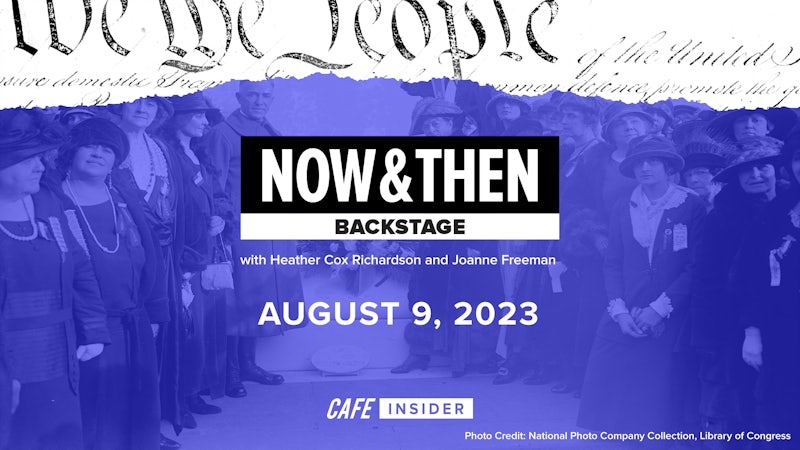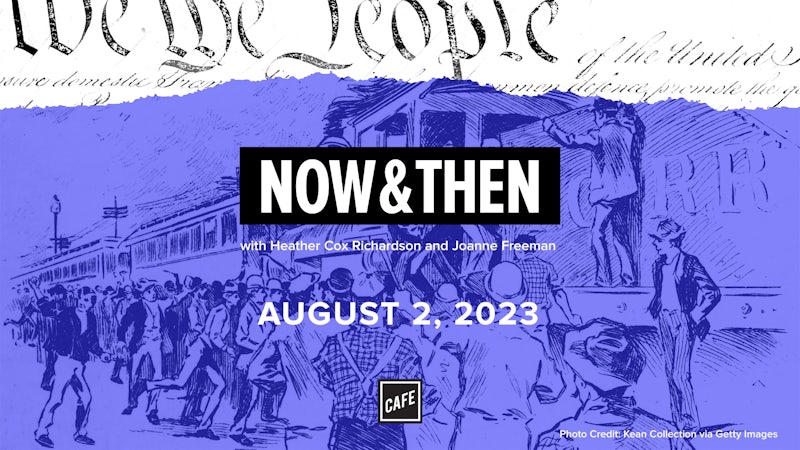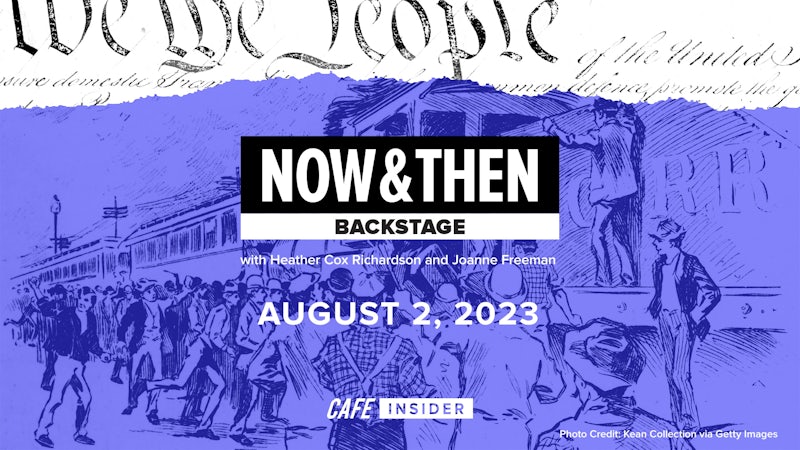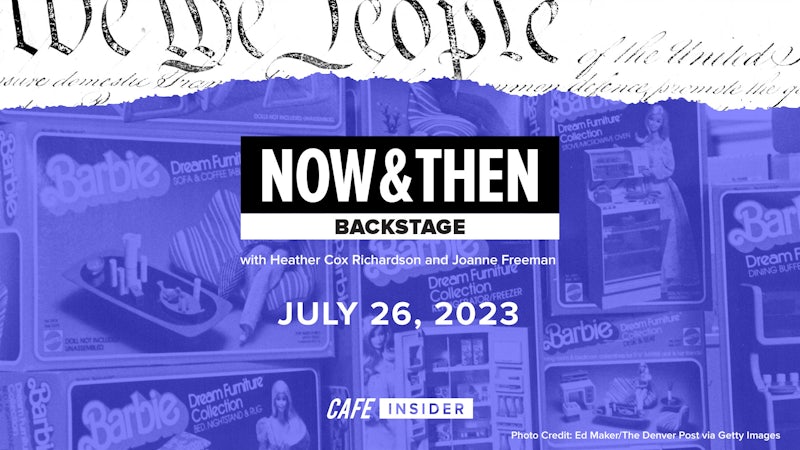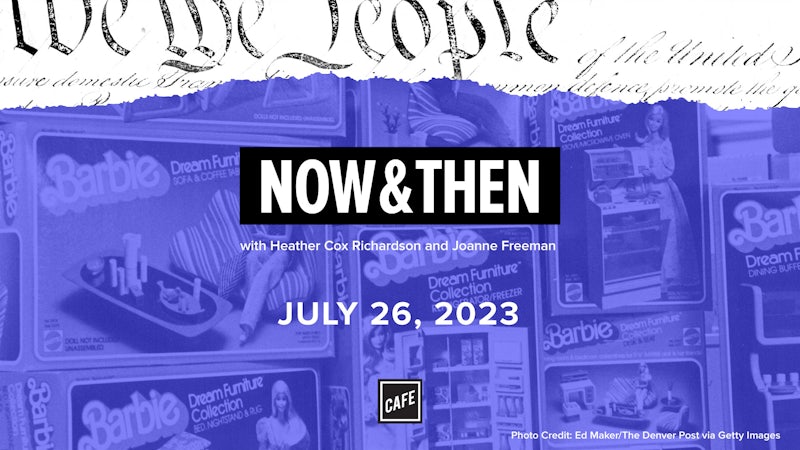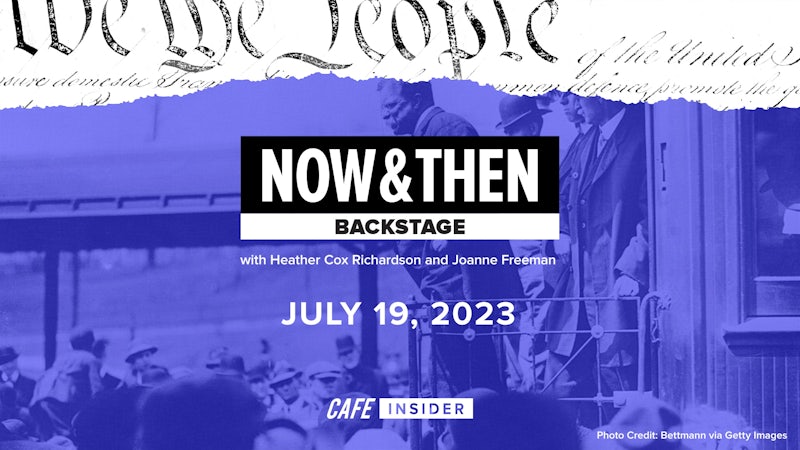Heather Cox Richardson:
From CAFE and the Vox Media Podcast Network, this is Now & Then. I’m Heather Cox Richardson.
Joanne Freeman:
And I’m Joanne Freeman. Today we’re going to talk about what’s going on in Florida and the standards for teaching African-American history that are continuing to perceive a lot of comment. What Heather and I are interested in talking about here is not so much paging through the standards and correcting or not correcting various specifics, but what we’re interested in is the larger so what. Why does it matter? What are these specific standards as they’re set out now in Florida? What are they suggesting overall, and why does that matter, number one? And number two, how has this happened in the past and what can we learn from ways in which, let’s just call them strategic narratives about the past have been used in teaching American history in our school systems.
Heather Cox Richardson:
And I would push that even further and say that ultimately this is a question about why history matters, what history is and why it matters, and perhaps especially why it matters in a democracy. So the issue here is that the Florida standards for African-American history that were approved by the state on July 19th as part of a 216 page document outlining a broader social studies curriculum had a specific slant on Black history. Those standards were not just about history. They included finance, they included economics, government civics, and also interestingly, Holocaust studies, which has been part of the Florida curriculum for a while now. So it was not simply a list of things that students coming out of the Florida public schools should know about the Black experience in America. It was in many ways a worldview of what the state believed that Florida students should know to become participants in American society and that state board-
Joanne Freeman:
Should know and should not know.
Heather Cox Richardson:
Yes. And that state board, of course, was handpicked by Florida Governor Ron DeSantis, who has been pretty deliberately putting in place in Florida a different government that really oversees the experiences of Floridians according to the tenants of religious government or a government that embraces this concept of illiberal democracy. Get rid of democracy and replace it with something that looks a lot more like authoritarianism. The standards did a number of things when they talked about Black history.
Joanne Freeman:
The point that everyone sees Don and continues to talk about is the point about the various “skills” that enslaved people developed, which “in some instances could be applied for their personal benefit.” And the idea that slavery was in some way beneficial has been the point that’s coming up again and again and again and again. Now, we could march through these standards, you and I, Heather, and point to things that are either incorrect or weirdly stated or things that are missing. But to me, what really stands out and what people haven’t been talking about so much is the larger framing, meaning that whenever slavery is mentioned, it’s framed and surrounded by things to make American slavery appear in a certain light.
And I suppose one could say that that’s a sneaky way of framing a portrayal of slavery. It certainly is a more subtle way than stating incorrect facts, although there are some “facts” that are incorrect. But it’s this comparative framing that in one way or another, I’ve been saying using the word soft selling is somehow making it sound as though American slavery actually wasn’t so bad. It was a lot worse than many other places.
Heather Cox Richardson:
That, and also I’m going to make the argument that what these standards did is make it sound like American slavery was inevitable, that it was ultimately good for the enslaved people.
Joanne Freeman:
And it was learned elsewhere?
Heather Cox Richardson:
Yes.
Joanne Freeman:
Europeans learned it in Africa.
Heather Cox Richardson:
I would go beyond soft selling. To me, it’s like a fun house mirror in the sense that there are refractions that are not inaccurate, but the overall picture is so fundamentally warped. It is really disturbing and also intellectually a real attack on I think what this country was founded on and should stand for. I agree with you. I was not happy that people focused on that one line because that meant they didn’t look at the whole picture. The thing that everybody is writing op-eds about and talking about is a line in the standards that says that teachers should, and I’m quoting, “Examine the various duties and trades performed by slaves, e.g. agricultural work, painting, carpentry, tailoring, domestic service, Blacksmithing, transportation.” And then in this curriculum they have a clarification under those subjects that explain exactly what they want to have taught. And it turns out that this was even controversial amongst the group that approved these standards and added these standards.
The clarification was instruction includes how slaves developed skills, which in some instances could be applied for their personal benefit. Just to break that down a little bit, in fact, a number of enslaved people did have skills that they learned as they grew older and they were highly skilled workers. But the framing of this suggests first of all, that that was the majority of enslaved Americans, and in fact, this completely eradicates the incredibly violent menial jobs that so many did. They were never unskilled. If you ever think agricultural work is unskilled, you try it. But it also is interesting because it erases the fact that enslaved people who were highly skilled were chosen for their skills that they brought with them as opposed to being taught them in enslavement. This removes the agency from enslaved people and gives it to the enslavers. They learn things in enslavement.
Joanne Freeman:
So agency is the key word here, and scholars were talking about that to suggest that it wasn’t as though enslaved people had absolutely no power of any kind over anything, that they were doing what they could in their situation to survive it as best they could. But that has been warped in a sense, in these standards to suggest that, yeah, they can do what they want. They could learn handy skills, they can go on and use those skills after they are no longer enslaved, which is just on the one hand a warped way of understanding slavery, and on the other hand is denying and masking the very harsh reality of what enslavement was.
Heather Cox Richardson:
It also erases the transmission of that knowledge, African knowledge that built the United States. I mean literally Black African technologies came with enslaved Americans to the North American continent and brought us just off the top of my head, a lot of southern architecture, rice cultivation, obviously music, cattle handling boat work on the southern rivers. These were skills that Africans came with that Euro-Americans did not have
Joanne Freeman:
That have been entirely erased from throughout these standards.
Heather Cox Richardson:
That has been entirely erased. And even in this, the idea that somehow the active enslavement enabled Black Americans to get these skills, but where they’re learning those skills is also erased. They are not learning them from their enslavers, they’re learning them from other enslaved people who have extraordinary talent in iron making, for example, which was a big thing. And the reason I was so gobsmacked when I read this one is because it just sounds like that old trope that we’re going to talk about, that enslavement was actually good for Africans and later on Black Americans, because they were childlike tabular roses that Euro-Americans could imprint valuable skills on.
Joanne Freeman:
Because people have been so focused on that one particular point about beneficial skills being learned during enslavement, the focus hasn’t been so much on the many broader ways in which American slavery is being softened, denied, put in a context that makes it seem not so bad throughout. Particularly I would say grades nine through 12 when you read the standards as a whole, but still that’s the framing for the teaching of slavery in these standards. So here’s one example of that, and this is consistent throughout. So when American slavery is discussed, it’s always discussed in a world context.
So the standards will say, for example, ninth grade through 12th grade level, examine the condition of slavery as it existed in Africa, Asia, the Americas, and Europe always again and again and again. It has that comparative way of looking at things. Now, specifically, it says, “Instruction includes how trading and slaves developed in African lands, instruction includes the practice of the Barbary pirates and kidnapping Europeans and selling them into slavery in Muslim countries. Instruction includes how slavery was utilized in Asian cultures. Instruction includes the similarities between serfdom and slavery and emergence of the term slave in the experience of Slavs. Instruction includes how slavery among indigenous peoples of the Americas was utilized prior to and after European colonization.” Now you can march your way through that, and in some cases I think it’s incorrect. In other cases, you could say, okay, fine, yes, the Barbary pirates did that, but the fact that somehow or other you need all of that, but
Heather Cox Richardson:
The Barbary pirates did it for a handful of people.
Joanne Freeman:
Yes, exactly. A handful of people that got a lot of press because gasp White people were being captured, and you’re right, a handful of instances and receiving lots of publicity and books were being written about them. You could say, well, as some did when I first objected to some of this. Well, it’s not bad to talk about slavery in a comparative context. No, it’s not, and it’s not bad to mention how it’s used in other cultures. No, not bad at all. But when you mention American slavery, always in that context, look at how it’s used in other places.
Look at how other people did it, look at how it was bad. Even worse, there’s a section that says compare living conditions of slaves in British North American colonies, the Caribbean, Central America and South America, including infant mortality rates. And initially it says, okay, let’s talk about the harsh conditions and consequences on British American plantations, and it mentioned specifically undernourishment climate conditions, infant and child mortality rates of the enslaved versus the free, because it does make the point again and again and again that the conditions weren’t so wonderful for White people in colonial America.
Then it says, “Don’t forget instruction, including the harsh conditions in Caribbean plantations, poor nutrition, rigorous labor disease.” None of those things get mentioned when you’re talking about American slavery. So that’s the fun house mirror component here is that you can point to individual facts and say, well, in one way or another, there’s truth in that. But when you add it up and you look at how it’s being deployed and you look at what’s being stockpiled as far as facts are concerned and how American slavery is consistently being framed, there’s a consistent message within these standards about how ultimately American slavery was bad, but it could have been worse and it was worse in a lot of other places, and we need to realize that there were aspects of American slavery that were, and they don’t use this phrasing, I am using this phrasing, not as bad as you think.
Heather Cox Richardson:
Yes, and one of the things that jumped out to me in that section was the degree to which these are really hard subjects and history teachers have a lot going on and to understand the different aspects of enslavement. For example, on the African continent where it takes a couple of forms but is not the legal system of hereditary racial slavery, which is going to develop in the North American colonies. Do you really think that they’re going to be able to say, “Yes. Well, there’s been a new study that says, well, this is going to get distilled down to exactly what you say. This wasn’t so bad and it started in Africa,” which is again, one of those things that technically kind of, but the way it later develops in the United States is an entirely new system that marries a global market economy to a certain way of treating human beings to produce surplus for that market that is just simply doesn’t exist in Africa in this period.
So that idea of the rise of these large plantation systems run by enslavement as, in this case sort of the Africans did it first. But then the other sense in which it is really misleading is the degree to which it makes it look as if all labor in colonial America was the same because you do have indentured servants, you do have indigenous enslavement, but there’s something really insidious about that in the sense we’re looking at it in the past. Well, slavery’s not that different than indentured labor. People aren’t treated very well, and yet if you flip that sucker that also says that nowadays we think of people who do labor as in parallel with enslaved people. Really we’re saying that in 2023?
Joanne Freeman:
It also leaks to an ongoing myth that comes up constantly, and that is there was White slavery in America, and normally what people are doing is pointing to indentured servitude and saying, “Well those were white slaves.” Well, if you understand what enslavement is, it’s not the same thing as agreeing to be contracted for a period of time as a servant with an indenture, and then that indenture ultimately expires and you gain freedom. I’m sorry, but that’s really not the same thing as slavery. So even that is a myth that doesn’t get refuted in any way and in some ways is upheld by this constant fussing of them together throughout these standards. It’s the framing and the subtlety of it and what’s in there and what’s left out and what comparisons are made. It is insidious, it is crafty in a way, and thus it’s easy to miss, which I think, again, a lot of people have done precisely that in focusing on the most offensive, incorrect facts that they have found in these standards.
Heather Cox Richardson:
People writing these standards wanted to tell a certain story, and they went and they found pieces of our history that enabled them to tell just that story.
Joanne Freeman:
And that’s what you and I as history teachers, this is a prime thing that I teach my undergraduates. If you want to prove something, you’ll be able to prove it by delving in and rummaging around and picking the facts that support what you want to prove, and that’s not the way you do good history. You interrogate the past and you see what the evidence suggests and you analyze and you draw conclusions. You can cherry pick to your heart’s content to prove anything, but that’s not historical analysis.
Heather Cox Richardson:
Let’s talk a little bit about that, about what history is and why it matters that we get it right. So what’s your definition of what history is and why do we care?
Joanne Freeman:
Wow. If you’re talking about national history, it’s how we got to where we are, for better and worse, good and bad. We can’t understand where we are, how we got here and where we might be in future if we don’t understand the patterns of the past. The ways in which ideas and actions have led to outcomes and how that has evolved over time. In the case of the United States of America, in the case of a democratic republic, which is what we are a democratic republic, so you’re talking about the nature of something that can easily be warped, which is democracy. To understand what democracy is and isn’t and how precious it is and how much it needs to be worked at and protected, you have to understand our history and history is the only way in which we can really understand that story, understand the perils of the moment that we’re in, and have a sense as to what people in the past did or didn’t do about it and what we might be able to do towards the future.
Heather Cox Richardson:
So my definition is similar in the sense that I think history is the study of how and why change happens, what creates change, and in order to understand change in the future, you have to understand what you think created change in the past. And what that means is that you must be as accurate as you possibly can. One of the things that always jumps out to me is I have very strong political ideas, but when I do history, those are often revised because when you actually start doing the work, you’re like, “Wait a minute, that’s not actually what happened,” and I have to revise the way I’m thinking about X.
Joanne Freeman:
And that’s some of the joy of doing historical research and analysis is that you have certain assumptions or you have unchallenged ideas and you do research and you find evidence. And your response to that is, “I understand this thing differently in the past that will lead me to evaluate how I understand it, the legacy of that thing.” Part of the joy and the thrill of “doing history” is finding evidence, not necessarily always brand new evidence, but asking different questions of evidence, seeing something in a different a way, and being able to understand history, past and present, in a different way as well.
Heather Cox Richardson:
To me, it is vitally important to get it right even if it is not the political direction that you might want something to go, and this is an issue across the board, people who cherry pick what they want to see in the past. And the reason that I viscerally recoil from that is that if you don’t get that right, then you are thinking the patterns are different than they are and you’ll make bad decisions going forward. So if you erase the Black experience and the Black participation in the construction of that country, we don’t have an accurate picture. If you pull those people out, you don’t have an accurate picture.
So you might make decisions that say, “Well, if in fact these White guys were teaching these enslaved Africans, everything they know. Clearly White people know more than Black people do.” That’s just so wrong. If you actually look at what actually happened, like I say with Africans coming over with incredibly sought after skills, they’re on the ground floor too. And part of the way that the standards present history is not only the idea that a certain group of people are the ones who are really moving the ball forward, but also that they are individuals who are moving the ball forward, which erases the vast majority of labor and community that have gone into building American society.
Joanne Freeman:
We’re talking about humanity, we’re not talking about individual heroes and sure there are people who deserve to be noticed and held up as examples of people who did difficult things in difficult times, but we’re talking about the human experience in one way or another and the humanities as an understanding of the human experience.
Heather Cox Richardson:
The other thing that really jumped out about the standards is that certainly African-Americans are mentioned in this general social studies curriculum that covers, as we said, so many different aspects. But whenever they are participating in shaping the United States, first of all, as you mentioned Joanne, there’s that standard that says there should be a focus on both white violence and also Black violence. Absolutely true. Occasionally Black people committed violence, but that’s not the larger pattern at all, but that in the standards, African-Americans really never exercise is agency in terms of pushing back against racism. And when you talk about people like Rosa Parks, I don’t know, I guess it’s just about her feet, which is not at all what was going on in the Montgomery bus boycott or the fact that she was a early participant in the NAACP who kept records of sexual assaults and of lynchings in the south from the 1940s forward, and that was part of an organization and a deliberate effort to push back against reactionary Whites, and that’s just not here.
Joanne Freeman:
There’s no pushing back. You don’t see who the people are who are doing the repressing, who are doing the suppression. The people who are actually creating this system, the people learned it in Africa, there are people standing up for rights, but there’s barely a sense of what’s being pushed back against.
Heather Cox Richardson:
So I would make an argument actually that one of the things about this curriculum, and we’re focusing on what it says about minority representation in our curricula, but that it’s also about making sure school children don’t understand they can push back against an unfair system. I think that’s the untold story here in this, that what it does is it erases the ability of people to get together and say, no, this is not fair, and we’re going to push back against this. It is a portrait of a very firm society that has a very clear idea of the way the world works, and it’s overseen by… I’m sorry, wealthy White men.
Joanne Freeman:
And related to that too is that very consistently throughout in the civics aspect of this, but really anytime the nature of the American polity is mentioned, it’s very explicitly called a constitutional republic. Students will learn that the United States is a constitutional republic. Now it’s easy to dismiss that. It’s a democratic republic, it’s a constitutional republic. You can dismiss that as an exercise in rhetorics, but it isn’t because if you’re denying that the United States is a democratic republic, you’re basically carrying out some slide a van to not necessarily erase, but mask the democratic majority rule component of what’s going on here.
If you are trying to say, well, the founders wanted X and that’s what we should follow, it’s very handy to say constitutional republic. Democratic republic, along the lines of what you just said, Heather, about showing people protesting, not reminding students that they have that right. This falls in line with that as well. It’s masking a downplaying of majority rule protest, and it’s using the founders as a weight to create that mask.
Heather Cox Richardson:
This whole phenomenon in the present really jumps out to me as an echo of other times in America when people felt that they were losing control of the country. So in order to regain it, they went after the children. And I think it’s really interesting that there is such a focus right now in the American radical right on protecting the children. But what they’re really doing is using that language which is deeply embedded in our history to indoctrinate the children. The idea of going after the children and the classrooms has really deep roots.
So much of the information going forward comes from lawyer and historian Greg Hoffman’s 2019 piece in the journal facing South, it’s called Twisted Sources, how Confederate propaganda ended up in the South School Books. It also comes from a 2019 Vox article by Cynthia Greenlee that is titled How History Textbooks Reflect America’s Refusal to Reckon With Slavery. So the Daughters of the Confederacy undertook this very project in the 1890s in a really similar way, and it’s interesting that it’s the 1890s because of course this is not the Civil War generation, it’s their children. So in 1894, they founded the United Daughters of the Confederacy devoted to, as they said, “Honoring the Confederate War dead,” and these are the people who put statues up around the country and kept talking about the lost cause and how noble the sentiments of the Confederacy were.
But the daughters also created a group called The Children of the Confederacy, and they were devoted to teaching southern children a pro confederate vision of history, and they turned, of course to textbooks that glorified the Confederate cause and downplayed and sometimes entirely erased the role of enslavement in the Civil War. And in November of 1900, the president of the United Daughters of the Confederacy, Julia Weed, explained why this was important and just honestly, the parallels between the past and the present are just sometimes it doesn’t even rhyme. Sometimes it’s just-
Joanne Freeman:
It’s howling.
Heather Cox Richardson:
So we’d said, we must educate our southern boys and girls as true southerners should be educated in the full knowledge of our war and the causes that led to it. They must be taught the history of the war and the great men who made our country the glorious country it was, and we can only secure this by regulating the books that are put in their hands at school, never fault or in this work, it means everything to us and our children.
Joanne Freeman:
Another example of this, 1909 at a United Daughters of the Confederacy Convention in Wilmington, North Carolina, division President Mrs. I.W. Faison explicitly called out the lost cause and argued that textbooks could help ensure that people understood that the Civil War was a fight for state’s rights and Southern independence, and that there would not be a focus on enslavement When people talked about the Civil War.
She said, “We must see that the correct history is taught our children and train them not in hatred towards the north who differed from us, but in knowledge of true history of the south and the war between the states and the causes that led up to the war so that they will be able to state facts and prove that they are right in the principles for which their fathers fought and died and continue to preserve and defend their cause until the whole civilized world will come to know that our cause was just, and right.” There is an expression often used by our people as the “lost cause.” Let us forget such for it is not the truth. No, our cause was not lost because it was not wrong.
Heather Cox Richardson:
And worth putting this in some context. This is in the late 1890s and the 19 aughts, and this is a period when after the 1880s when the economy was pretty good and actual lynching drops from about 1871, ’72 until 1889 in the American South, it continues quite high in the American West. On the heels of that, you can see this cultural pushback to try and keep a White understanding of the south, but then when there’s a new push in 1889 and 1890 to protect Black voting in the south, again, lynching goes off the freaking charts and culturally, there is this idea that Black Americans should not be included in White American society, which becomes defined as American society. So you have people like Weed and Faison redefining America again as a White republic, but then also saying, “We got to convince the kids of this too.”
Joanne Freeman:
As you said before that we’re even beyond rhyming with history, simply denying big, big facts. So for example, 1919, the United Daughters of the Confederacy set up not surprisingly, a committee on textbooks explicitly, and it was led by a woman named Mildred Lewis Rutherford, who worked at a women’s academy, the Lucy Cobb Institute in Georgia. And she routinely claimed that the entire concept of slavery had been invented by abolitionists and that enslaved Black people in the south had been more like indentured servants. Is that echoing for you at all? Based on where we began this conversation, the textbook committee became known as the Rutherford Committee.
Another leader on the Rutherford Committee was North Carolina, former Confederate General and industrialist Julian Carr famed for a staggeringly white supremacist speech that he gave at the unveiling of a confederate monument. Actually, we’ve heard about this too recently. Silent Sam on the campus of the University of North Carolina, and here’s what he said in that speech in 1913, “The present generation I am persuaded, scarcely takes note of what the Confederate soldier meant to the welfare of the Anglo-Saxon race during the four years immediately succeeding the war when the facts are that their courage and steadfastness saved the very life of the Anglo-Saxon race in the south when the bottom rail was on top all over the southern states and today as a consequence, the purest strain of the Anglo-Saxon is to be found in the 13 Southern states. Praise God.”
Heather Cox Richardson:
Just want to point out there too, that we’re probably not going to get much into in this episode, but the person who found that speech recently is a Black woman historian named Hillary Green, who was doing a project on these and discovered that speech.
Joanne Freeman:
Another way in which people like to denounce historical discovery or new insights is to sneer at it as revisionist. I hate revisionist history. Well, history is constantly in a process of being analyzed, researched, investigated, there’s new evidence found, there are new questions being asked. This is a great example of evidence being found by a scholar giving new insight into something that happened in the past and thus new insight into the present.
Heather Cox Richardson:
Except that it usually brings in new information that certain people don’t like to see. And speaking of rhyming or mirroring, the Rutherford Committee in 1919 actually issued a pamphlet called A Measuring Rod to Test Text Books, and Reference Books in Schools, Colleges and Libraries. The pamphlet included lists of, “That ostensibly backed claims that the north was responsible for the war between the states.” That’s a quote. “The war between the states was not fought to hold the slaves.” Another quote, “And slaves were not ill-treated in the south. The north was largely responsible for their presence in the south,” and the pamphlet went on to offer guidelines as to which textbook should be rejected.
The Rutherford committee said, “Reject a textbook that speaks of the slave holder of the South as cruel and unjust to his slaves. Reject a textbook that glorifies Abraham Lincoln and Vilifies Jefferson Davis, the President of the Confederacy, unless a truthful cause can be found for such glorification and vilification before 1865. Reject a textbook that omits to tell of the south’s heroes and their deeds when the North’s heroes and their deeds are made prominent.” The next year in 1920, the Rutherford committee published a much longer text called The Truth of History that called out textbooks by name that the committee found were insufficiently generous to the south.
Joanne Freeman:
Now, not surprisingly, the textbooks that the United Daughters of the Confederacy pushed during and after the Jim Crow period have that same message, that same tone, and that as we’re going to hear in a moment even glorification of enslavement that again, all kinds of echoes ringing out here. For example, the UDC endorsed in North Carolina, an influential 1907 textbook entitled Young People’s History of North Carolina. It was written by Daniel Harvey Hill Jr. The son of a Confederate general and the longtime president of North Carolina State University, and here is how Hill described human enslavement in the South. “As a rule, the slaves were comfortably clothed, given an abundance of wholesome food and kindly treated.
Occasionally some hardhearted master or bad tempered mistress made the lot of their slaves a hard one, but such cases were not common. Cruel masters and cruel mistresses were scorned then just as men and women who treat animals cruelly are now scorned. These slaves were brought into the colonies fresh from a savage life in Africa, and in two or three generations were changed into respectable men and women.” This is actually hard to read. “This fact shows better than any words can, how prudently and how wisely they were managed.”
Heather Cox Richardson:
Because what you’re saying is the skills they learned in slavery they could use later on for their-
Joanne Freeman:
Yeah, they benefited enormously.
Heather Cox Richardson:
Really worth pointing out here that although I am being snarky about how similar the modern day stuff is to this older stuff. It’s really important I think to recognize, as you say, Joanne, the larger picture here. The idea that enslavement was kind, that people were well-treated, that these were childlike people who were shown the light and the way to, and I’m going to put this in air quotes, “civilization by their betters,” it erases reality. It erases who’s actually doing the work. Who is forming the communities, who is going to church, who is becoming sculptors, who is doing scientific experiments, who is all those equal participants in the construction of American life.
Joanne Freeman:
That creates a false idyllic past that can be constructed as the person constructing it sees fit as a way to highlight certain things in the present and mask or not focus on certain things in the present.
Heather Cox Richardson:
Well, and I think there’s an aspect, and I harp on this a lot, but the idea that people who want to go back to that perfect past are serving the needs of authoritarianism, which always urges people to go back to when the world was perfect and you guys were the ones in power. There is no perfect past and democracy is all about constructing going forward. So there’s partly that. There’s also that there you go beyond in some of those older textbooks, the idea of shifting the focus and celebrating the south to pure indoctrinations. So for example, the United Daughters of the Confederacy by 1915 were pushing a text that went further than simply saying, “Enslavement wasn’t so bad to attacking Lincoln for the Emancipation Proclamation.”
The man who wrote that text actually said, “Shall we honor Lincoln for his emancipation proclamation? The Blackest crime laid at the door of George III was that he unleashed a handful of savages against our frontiers. That Lincoln, as far as in him lay unleashed 4 million savages into our very midst against our defenseless women and children.” I guess that’s part of this warping of American history that also worries me is that the step from enslavement wasn’t so bad to, we need to continue to perpetuate the system because otherwise we’re unleashing, in this case, savages on American society is a really short step in our history, and you can literally see it right here, how the radical rhetoric on the right escalates and escalates very, very quickly.
Joanne Freeman:
It’s laying a pathway of thought that is very easy to march down that pathway and draw some frightening conclusions. Now, I think it’s important to note that even as the United Daughters of the Confederacy and other such groups were flooding southern public schools with that racist and denial form of history and the strange version of enslavement in the Civil War, there was a group of Black scholars and activists who were pushing back on that dominant narrative. So for example, in 1890, Black North Carolina lawyer, Edward A. Johnson published a textbook entitled A School History of the Negro Race in America from 1619 to 1890. And Johnson, it’s worth noting, eventually moved to Harlem and became the first Black member of the New York State Legislature in 1918. And in his book, he highlighted the dehumanization that Black students must feel by being erased from history textbook.
So Johnson wrote, “How must the Little Colored Child feel when he has completed the assigned course of US history and in it found not one word of credit, not one word of favorable comment for even one among the millions of his four parents who have lived through nearly three centuries of his country’s history.” Then in 1912, Washington DC based Black teacher Leila Amos Pendleton published another textbook called A Narrative of the Negro, which was a pioneering text that directly addressed Black children about the horrors of enslavement and included information that had simply been excluded from mainstream textbooks on African societies and on abolitionism.
So here’s a bit from Pendleton’s book, “Picture to yourselves dear children, a small group of foreigners frightened and sad with hearts aching for home and for the loved ones from whom they had been torn. The early part of the 17th century belongs to the dark ages of the world’s history to the time when men had not yet understood that it’s the right of every human creature to be free, and that is a solemn duty of every man and every race to help toward true freedom every other man and every other race.” Now, if you think to yourself how nothing even remotely like that was in textbooks at the time, imagine the power of children, Black and White, encountering that in textbooks.
Heather Cox Richardson:
The idea of these textbooks that continue to celebrate the thinking of the United Daughters of the Confederacy by the 1970s is really being challenged across the American South.
Joanne Freeman:
So for example, in Mississippi in 1975, the State’s seven member textbook review board rejected along racial lines five to two, a textbook named Conflict and Change, which was actually an award-winning textbook that included photographs and descriptions of lynchings and other acts of vigilante White violence. In its place, the textbook committee approved a book titled Your Mississippi, a text centered on the lost cause that depicted the KKK as a fraternal club and included virtually no information on enslavement related violence or lynchings.
Now the authors of Conflict and Change, James Loewen and Charles Sallis teamed up with the NAACP Legal Defense Fund to sue Mississippi, citing first amendment rights to free speech. In a 1980 trial in the United States District Court for the Northern District of Mississippi, Judge Norma Smith sparred with the textbook committee chair John Turnipseed in a back and forth that highlights the absolute denialism of what is represented by the lost course narrative. And again, where we started out discussing in Florida standards, Judge Smith said, “Didn’t lynchings happen in Mississippi?” And John Turnipseed said, “Yes, but it was all so long ago. Why dwell on it now?” And Judge Smith responded, “It’s a history book, isn’t it?” Smith ultimately ruled to compel Mississippi to teach conflict and change arguing that the textbook board had been racially biased in their selection process and had denied Loewen and Sallis their first amendment rights.
Now, the larger point that we’re making here, we’re talking in part about history, what it is, what it does, what it should do, what it can do, and how it’s interwoven with an understanding of American democracy. We’re also making a larger point here about the fact that the struggle that we started out by talking about represented by what’s going on in Florida, has a long history, has been ongoing and is still ongoing, and why that’s so important. Why what we should be talking about here is more than individual facts that are howlingly wrong and are saying things in a highly unjust and inaccurate way.
But even more than that, the framing, the larger story being told in the Florida standards, that story is masking and denying and pedaling a particular story that cuts out an enormous part of the American story. The American story is a huge, diverse, complex, conflict-ridden story, and all of that needs to be there for good and bad, for better and worse if you want Americans to understand the meaning and the struggle and the possibility of America.












